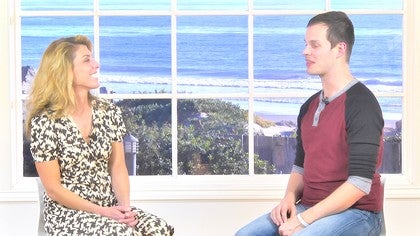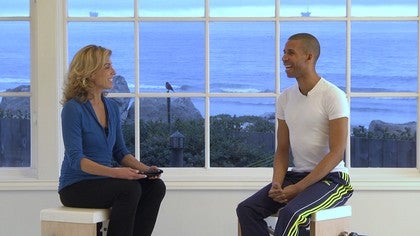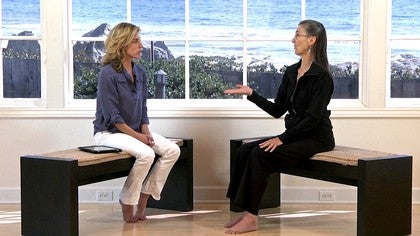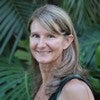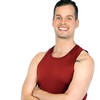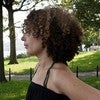Description
You are sure to enjoy this insightful discussion and will likely gain a broader perspective on the scope of what Joseph Pilates intended with his method of body conditioning.
Photos of Lynn Simonson courtesy of Lynn Simonson.
About This Video
Transcript
Read Full Transcript
Chapter 1
Benjamin's Background and First Pilates Teachers
Welcome to another discussion here on Palladio's. Anytime. Our guest today is Benjamin Degenhart. Benjamin is a former dancer, a teacher and the creator of three 60 philosophies and educational program designed to reconnect movement teachers, any training background with the original teachings of Joseph PyLadies and perhaps most notably these days, Benjamin has been collecting information and he's known for having a great collection of works on Joseph [inaudible], the man himself with particular interest to me and everyone here at PyLadies anytime. So thank you for coming. Welcome Benjamin.
I moved to Holland then to start my formal dance training and becoming a professional contemporary dancer. Um, which was when I was first introduced to Polaris. So my first exposure to pull out was with three weekly Mat classes that were part of my dance training. And, um, I remember it being really funny because when I auditioned for the dance program, I, um, I auditioned for the musical theater program and I had to sing a song and I'm not a singer. Um, so the teacher recommended a very simple song and it was, um, pilot's dream, which is I think from, um, Joseph, the music musical, Joseph, I don't remember. But, um, the song was called pilot's dream. And, um, a few weeks later when I was admitted to the school, I saw the word [inaudible] on my schedule. And at that point it was all very blurry to me. I had no idea what to expect from pilates. I had no idea that it was the name of someone. Um, I just knew that it was a really tough class and I didn't really love it right away. I just, I just wanted to dance.
I wanted to be up on my feet and work on my jumps and my turns rather than being on my back and being in pain. But I do remember, um, having an incredible impact on my own, my dance performance and my technique. Um, every time I came out of a [inaudible] class, um, I had three different teachers. Um, Marianna Fund, groomsmen, Yvonne Schoeller and Carlo deckers, who are all Romana trained. Now at that point, I had no reference as to what that means. Hoomana isn't the world or I didn't even understand the concept that plot has existed outside of that room, but that was my first exposure to the word.
I received a scholarship to move to New York for six months. I stayed for a year and a half in the end. But, um, I, I trained under Lynn Simon sons who developed a technique that is about physical development for adult beginners in dance. And that way, closely related to is in a way and movement. Um, and she was really the first one for me to, um, give me the eyes to see and, and the tools to communicate movement, um, on a much higher level and really cultivated this love planted the seed for me to, um, fall in love with teaching movement. And that's when I first moved to New York.
So I feel like I always wanted to teach dance more than actually being a dancer. Um, and that is sort of a trend that continued throughout my life. I, I love sharing my own journey of discovery with other people.
I moved back to New York in 2007. I moved for love. Um, and at that point I, I transitioned into a full time teaching career and pull out Easter seemed the perfect medium for me to, to work with people that are not just dancers, people that are not just injured, but, um, try to cover a huge spectrum of people that I could explore with explore, um, you know, um, methods of physical development.
But, um, it truly is about movement for me. There's, um, it's, it goes beyond technique and methods and, um, sort of anticipating, talking about my historical research a little bit. Um, there's been a huge shift for me that when I hear the word polarities, I no longer think of the a hundred and the role of in the role of her. But, um, I have a direct association with the man. So when I hear the word PyLadies, I think of this is a man, this was a man, this is somebody's last name. And I started to feel troubled using his last name to, um, label my teaching, um, because what I teach is Degenhardt, if that makes sense. And, um, now I still use his work and my interpretation of it, which is why I say I have an affinity towards control ology. But when I talk about PyLadies, I usually mean it in reference to the work of Joseph pilates. I find that, um, in this day and age, people have a bias towards pilates and expectations when they hear the word [inaudible]. And oftentimes I find myself struggling with those expectations when I, um, want to just create a safe as open and moving experience as possible. So I, I find that by choosing a word that people don't have any expectations for other than people that know what it means. Um, I get to have deeper going conversations about the work, about the men, um, without people thinking in the back of their minds. Oh, I've seen Palladia I know what it is when most of the time that's not really true as we all know. So, um, most of us can't say what it is yet that have been teaching.
None of us can truly. Um, and, and then again, because it was somebody else's last name and he, you know, he referred to a studio as the Pilati studio ad to the Polis Gymnasium. He referred to his method as the plotting method of body conditioning. But, um, from what I understand, he would never say, um, come and do politics. It's common. [inaudible] what can, what is controller to then control ology is, um, he defined it, didn't he? So I think yes. Um, control ology is the balance of body, mind and spirit. Controller. GG is, um, a method of physical development that he, based on physical culture of his time and it is um, a method that incorporates exercise. It incorporates lifestyle as in not as in what you eat and what you drink, but as in how you live your life. Um, he was very keen on the furniture that you have in your apartment. He, um, a lot of people don't know this, but he was really trying to have you treat your body better during non-moving times as well. So it's not just about the one hour you spend at the studio, but once you go home, you shouldn't sit in a chair, you sit should sit in a chair. The challenges or challenges you would have set up, right, sleep in a bed that makes you move while you sleep and so forth. So there's, um, then then just the exercises. Yeah, I believe if January said that she's thought Polonius was a concept and I think that's true. It's a philosophy. It's a concept. There is, there is a method, there is, um, very clear margins within which he operated.
But within that there was always space for creativity for evolution. And you see that he created this arc in his work that um, did change exercise orders, changed exercises changed, some were taken out, some were put back in. Um, so it was never just one static thing, but it always, it always served the same philosophy and the same concept. What is it? Physical culturalist Benjamin physical culture is really an umbrella term for the way people thought about the body and how to keep it healthy maintenance practices. Um, there was an understanding that um, lifestyle started to change and that um, evolution on an evolutionary level, we were still not quite adjusted to modern lifestyles and that um, occupation started to become more sedentary, people started moving less. Um, there, there was a paradigm shift in, in physical education in schools. Um, and physical culture really stood for trying to turn back the clock a little bit and trying to stay true to what the body's is meant to be able to perform on its own. Um, as far as movement goes, as far as organ health goes. And there was this general idea that if you keep moving your body the way it's supposed to, it keeps functioning the way it's supposed to.
And there was a breakdown as far as exercise development exercises go. There was a breakdown into organic exercise, um, which was really about strengthening the muscles that support your organs and um, create vitality in your body. So truly meaning organic as in holding your organs in place and keeping them stimulated through massage. Um, working the belly work in the back, working the seed and all of that working that cylinder that we sometimes turn the power house, but it had less to do with creating superficial strength but rather massaging the inner organs. Um, so that was one branch of exercise. Another one was corrective exercise, which really dealt with, um, offsetting bad postures, exercises that strengthen the spinal column, which houses your it system, if you will, your spinal cord. Um, so any spinal defects that came from too much sitting at the time or from living sedentary lifestyles, um, fell under corrective exercise. And then there was constitutional exercise. Um, how much insurance do you have? How much stamina do you have? Can you, can you live your everyday life without strain or pain?
And that was sort of the benchmark for, for fitness. Are you fit enough to live your life? And of course that meant something else. For somebody who's working at a desk all day long versus somebody who is a professional athlete or dancer, how does control energy fit in this physical culture genre? Well, um, as I explained and as far as exercise goes and physical culture, there was a distinction between organic exercise, corrective exercise and constitutional exercise. I think controlling g was really trying to combine and unite those three things. Um, and you know, one of the things we struggle with today is it can be so many different things.
It can be part of your rehab plan after, after, um, after recovering from an injury. It can be part of your, um, physical development for athletic disciplines, for, for big events. Um, it works very well as just a form of exercise too. So, um, he really managed to put those three things into the same method, into the same system and work from there. So what also happened during that time, um, is that in, in, in the school system, in the education system, um, sports and athletic, athletic disciplines, um, became more incentivized, if you will, um, versus physical culture and physical education where you just move your body to do gymnastics and so forth. It became less and less about movement skill and more about excelling at any one sport. And that is one of the trends that Joseph Party's forest saw. Um, along with the other physical culturalists and um, tried to offset, um, he wanted to get physical education and culture back into the schools. Um, Pilati [inaudible] or country ology or whatever you want to call it, um, was really, um, a means to support your physical body in whichever activity you choose, whether that's an athletic discipline or a sport, um, or just sitting in your chair all day long if that's what you had to do.
Chapter 2
Digging Deeper into the History of Joseph Pilates
So physical culture was really all about health and the understanding that health cannot come without activity.
I'm not sure if he was truly ahead of his time, if you've seen them in context of all the other people that were working at the same time. There were a few things that were very unique to his work, but, um, he was definitely inspired by this, this group of, um, physical. Yeah.
So there was a much more wholistic common sense understanding of movement and how, how to approach it, how to maintain it. Um, and I feel oftentimes in our time that people are very timid when it comes to exercise and that they're almost afraid to move, that they feel like movement has become so complicated because they might be doing it wrong. So they need a personal trainer and they can learn how to move without somebody watching them for an hour. And yes, in many cases that's, that's true nowadays because we become so detached. But I think that originally this work was truly about being kid again, learning to move all over again. We're moving gravity. I'm gradually introducing load and resistance for the apparatus and so forth. Um, but truly relearning to move reforming the way you move.
You need to live a body conscious life and that includes your furniture, um, the way you behave during non-moving times basically. Um, take as much vitamin D as You can through sun, breathe in fresh air, um, taking good care of yourself and being, um, living a humane life, if that makes sense.
And at that point I was certified to teach Pilati. So I was, I was teaching a few classes there, but I did not know how to teach Palladio's in German. So I remember having, um, Elisia and Garrett's book, um, bodies in motion, um, both the English and the German translation Ami to sort of translate my knowledge. Right. So thanks to our translators. That's what my students got at the time. But, um, I remember my grandfather, my late grandfather, Pete, over my shoulders and looked at, I think it was the open like rocker, and he said, Oh, you guys still do that nowadays. And I, I wished I would've just dug a little deeper and asked him. But, um, I started to understand, oh, maybe these exercises have been around. Maybe they weren't done independently of piles. Yeah. Um, and then years later when I started having all these questions about the original of the work, I, I wanted to find more inflammation. And I started by, um, just getting all the footage that was available Marybell and sales, the DVD power plotters had a DVD. So I watched those. Um, but I just started this obsession almost. Um, and I went, well, I know you can relate. So another, um, place where I found a lot of inspiration from my historical research with Jacob's pillow, I used to go there in the summers just to watch dance. It's a beautiful place. It's in a national historic landmark. It's preserved, it's in nature. It's, it's, it's, it's just beautiful. And I remembered one summer being there that, um, Joseph [inaudible] used to teach there.
One of the tidbits I knew about Joseph [inaudible] and I walked into the archives and, and met the director of preservation there and, um, got access to a lot of information through Jacob's pillow as well. And I mean, just, just being in that place. Um, it's, it's where, you know, the famous video was, was done where he's, um, doing jump ropes and yeah. Yeah.
He was actually a model in many of his videos, um, that draws the plot film at his studio in New York. Um, so I, I learned about that relationship between Joseph plots and Ted Shawn and Ruth San Denis, um, and all these people. But there was a, a manuscript of Tet Shawn's biography, um, that had an unpublished section that talked about his friendship with Joseph [inaudible]. And, um, there was some gossip in there, but that was definitely one of the more, most memorable pieces that um, that showed a little bit of the character that draws a plot. He's had, um, he was a bit of a rascal. He didn't want to play by the rules and um, there was uh, a ditch in their friendship that made Ted Sean just lose his temper and fire Joseph pull out, he's after a couple of years. Um, so, so that was one of the pieces I found there. Um, and Norton Owen who is the director of preservation at Jacob's pillow, he hosted a symposium on Joseph [inaudible] in 2010, um, which had many alumni of Jacob's pillow from the forties and 50s. Um, actually come and speak about their experience. So I, I got exposure to that footage. It was all filmed that is still there and I strongly encourage everybody who has a chance to go there, go and see some dance, go to the archives, watch that video. It's very insightful.
That's just as much information on Joseph [inaudible] as he has at Jacob's pillow, at the New York public library. Okay.
You just need to be there and put in the time. Yeah. Um, so there's a lot of written documentation that clearly outlines what, what he was trying to accomplish. Um, for instance, his, well it was his desire to publish a third book, which speaks about furniture and his, um, posture correcting bed. So he was collecting testimonials for that. So it's very clear that that was an important part of his philosophy and concept. And I argue whether pilates or controller g was ever meant to stand as a, as a form of exercise only to me, um, physical hygiene, exposure to sunlight breathing, um, exercise as well as better lifestyle choices as far as furniture goes and so forth. I think those three things were, we didn't link together for him.
What actual documents did you find?
I can show it to me. Yeah. Um, but um, point being most of the exercises were truly around before, um, before Joseph [inaudible]. I would assume that those were exercises that he learned growing up as a kid because again, back then gymnastics were very big in Germany. Calisthenics were very big in Germany, so it wouldn't be surprising that he was exposed to those exercises early on. So did he invent those? No. Did he sequence them together based on his belief system of what would make a complete sequence of exercises to really address the whole body?
Yes. But, um, and that is true for the apparatus as well. A lot of the apparatus is actually derived from devices that we have seen as early as the 18th century, if not before. There's only so far I've gotten back in time at this. Yeah, we haven't. Where do you see that, um, physical culture, books, old literature, Genre, physical culture. It is. Yes. Absolutely. Absolutely. That's cool. Um, so yes, he invented a lot based on his needs and based on his philosophy, especially later in life, all the smaller pieces of apparatus were really corrective tools for him that, um, cater to a specific need that he encountered while teaching movement. Um, I was jokingly say he had an app for that, right. He, um, if he had no means to correct something, um, it was a better use of his time and energy to create an apparatus that will teach you a very specific movement skill versus using complex verbiage as we like to do nowadays. Right. Um, that was not available to him as far as I understand. Right.
He spoke English fine, but I don't think a lot. Um, so again, did he invent? Yes, but I think more than that, he was a really resourceful man who drew inspiration from, from the materials that were available to him and whatever fell into the margin of his philosophy of how to train the body, which was according to the way we processed movement when we were kids. Um, with again, gradual exposure to resistance and load. Um, slowly coming from lying down to standing up. Um, everything that fell into that margin became part of his work. Of what you've collected, what stands out the most for you or what do you think would stand out the most for me? Well, there's, um, a 16 page brochure that I found at the New York public library. It's, um, it's titled Return to life and I don't know who wrote it. My assumption is that it was Frederick Graham Rogers who was, um, writing a lot about movement and dance at the time. I think he helped, he wrote the forward for return to life. Um, so the verbiage sounds very much the same. So I'm not sure if Joe actually composed it, but what is spelled out in those 16 pages is what control algae is what it is not did you read it, how it's supposed to be taught and what his plans for the future were.
And that to me is eight letters. It's all right there. And I'm, all of these questions that we have about the work are, um, vaguely answered, answered in those 16 pages and I think they're incredibly meaningful and they helped me really understand my, my own perspective to the work. So within this document, it is clearly outlined what controller g is, what it is not, um, how it's supposed to be taught and what his plans for the future were. And for me, I think that is something that I hope at some point everybody gets to read. Um, it's, it's incredibly valuable in, in putting your own teaching intro perspective and, and see, see what he was really trying to do. He talks about, he talks about your organs, as I said earlier about organic exercise. He talks about your stomach and you'll get a new abdomen, but not so much about abdominal muscles. Um, he talks about your sinews, your connective tissue, your nerves, your blood flowing and all of those things.
And we've read that in your health and return to life. But this document is from I believe 1957 so you can really see that even later in the later part of his career or his life. Um, he stayed true to that philosophy and that even though a lot of things have changed, there was more parameters, more exercises, um, more people starting to work for him. The work started to spread itself out, um, throughout the u s um, the philosophy was still the same.
Yeah. So, um, yeah, he uses those words a lot and I think that's really at the, at the core, um, pun intended, I guess, um, of, of that time and, and physical.
It just is a very tedious process. I've been there, but it's totally worth it. And as, as you've seen by browsing through some of it, um, it's, it's, it's so meaningful. Um, and it just helps fill in some of the gaps that we have as teachers of, of this historical work. Um, and no matter where we take it in our own practice, I think even if you choose not to go the traditional route with the work, I think it's very important to, for it to be informed by an understanding of where it all comes from, especially if we call it Pele's. Um, where am I going to take this work for myself? Well, right now I'm really focused on three 60 [inaudible], which is my own education program. And I, um, I'm very fortunate that I get to travel and meet studio owners and teachers around the country and the world. And I wouldn't be honest if I said I didn't learn just as much as what the people that work with me learn. It's a true give and take and, um, it helps me put things again better into perspective as to what, what do people teach, um, what do people practice, um, around the country in the world? How do people engage in movement? And I think if there is such a thing as a next step, and I'm sure there's a longterm goal somewhere, but, um, I'm really just taking it one step at a time. But I think in the future, I really want to inspire the world to move every single day just to move.
And I know that sounds very grand, but, um, I think it, I think physical health is very simple at the end of it all. Um, movement obviously is a very huge spectrum, um, where you deal with decondition and dysfunction and, um, some of us are more removed from, from a physical health and others. Um, but once you are at a stage where your body's ready to move, you need to indulge in it every single day. And it doesn't have to happen at a studio. It doesn't have to happen under somebody else's watch. It's, it's a philosophy. It's a way to live your life.
Thank you very much.
The Teacher's Corner: Discussions
Comments
You need to be a subscriber to post a comment.
Please Log In or Create an Account to start your free trial.
